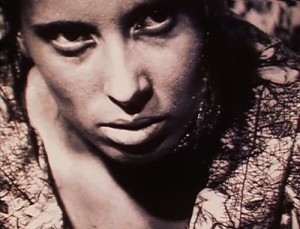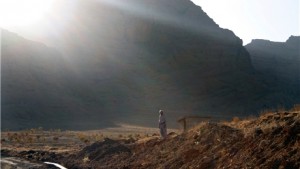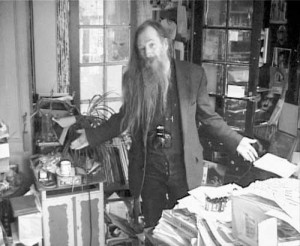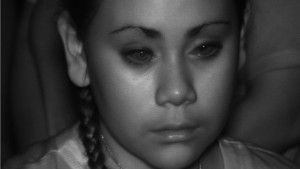
This program was put together for the Jihlava Documentary Festival in October 2007.
Impossible Home
My Own 1000 Square Metres by Atousa Bandeh Ghiasabadi (13:45 minutes 2006 mini-DV PAL)
Jaap Pieters Portret by Fred Pelon (45 minutes 2006 mini-dv PAL)
Paradise Drift by Martin Hansen (13:20 minutes beta sp pal, 2006)
This year the centre of the fringe world is in Holland. Who would have thought? All that orderly planning, the years of socialism making the art soft and far away, and now the children of Franz Zwartjes have come out to play.
My Own 1000 Square Metres by Atousa Bandeh Ghiasabadi
She wants to go home to Iran, she’s been seventeen years away from her country, her desert, and so she travels back to the emptiness to tend the garden of her thoughts. She stands in the middle of this promise, accompanied by the dust and her parents and her memories. She is waiting for the picture to leave her, though it may never, the lure is too great. In producing this movie she shows us only the most intimate scenes, which means mostly that they are unrecognizable. She risks producing a picture from this extreme vantage, while recognizing that by sharing it, she might lose everything. (Not only home, but the dream of hope. The hope. This is what makes this film ‘obscene.’ You have to see it only with one eye open, or out of the corner of your eye, at an angle, at a distance, from the back row.)
“As an immigrant I have always played with the idea of going back to my native country in my head. This longing is sometimes just an emergency exit door to give one the possibility of getting away. Away from one’s current personality. The privilege of being an immigrant is that there is always one’s personality in the past who had a different identity and there is always a place in the past which was one’s home. That’s how the idea of going back to one’s birth country seems like going back in time. And until now “to say something astronomically” we can look back in time(observing the universe from billions of years ago) but a real physical time travel is not possible yet and the idea of going back to the time that I left Iran stays illusive. Telling a story about this illusion is one of the aspects of this short film.”
Jaap Pieters Portret by Fred Pelon
A home movie, shot with understated brilliance by Buddhist maestro Fred Pelon. He is so deep into the no-thinking now that he can hear the music of his own body. Who could forget the famous experiment by American composer John Cage, who entered an anechoic chamber in order to experience, at last, a state of pure silence. Alas, he was met by the sound of his own body. This is what Fred hears now, when he slows the world down, the sound of cells knitting, of organs being rebuilt. Those steady hands, that infinite patience, the acceptance of the subject. He develops what the B’s typically name a “practice” (there is only the journey, the striving, never mind the destination), and then he picks up his camera and goes to visit his friend Jaap. Jaap is a well known filmmaker in the unknown world of super-8. He doesn’t believe in editing, neither his films nor his life, and everything he has come across is here somehow, in the stretch of his Amsterdam apartment. There are heaps of memory everywhere, and having disturbed a pile (an arrangement of the past, a living history) Jaap is forced to photograph it, chasing the tail of his own making, while the apartment drowns in its own history. Fred looks on, calmly, and then, while holding the camera rock steady for how long, ten or twenty minutes, he moves it with a sudden and certain flourish to establish a new outlook, a new position. The entire movie was made in one day, though all the years between them can be found here, looking back, looking forward.
Paradise Drift by Martin Hansen
The most perfect movie I’ve seen in the past four months. Here, t he filmmaker has opened himself to a place of serious looking, he has dedicated himself, just as those in front of the camera have dedicated themselves to come here at this uncertain hour. Like him, they have faith, together they are mirrors of faith. Their movements occur in the dark, at night, arriving as a tribe, a collection. They have come to bear witness, Hansen has come to bear witness, and we after him. The filmmaker trusts his seeing always, and so he waits. He knows that the most important part of using a camera is not using it. At last he shows us the mystery of a face, a hand reaching skywards, an exhausted torment, the sadness of having a body. He refuses to cover these bodies with stories, he is not going to let us off the hook so that we can put these strangers in their place. Instead, he gets close enough to show how far away someone can be, and from that distance, that real distance (as opposed to the false proximity that most close-ups in cinema produce) he discovers something touching. The glowing eyes, the upraised faces, the arms reaching to touch. Has so much longing ever filled a frame? They are from Bosnia-Herzegovina, and how many days has it taken him to find them, crouching together in the dark, waiting for the miracle of this film, this looking?





